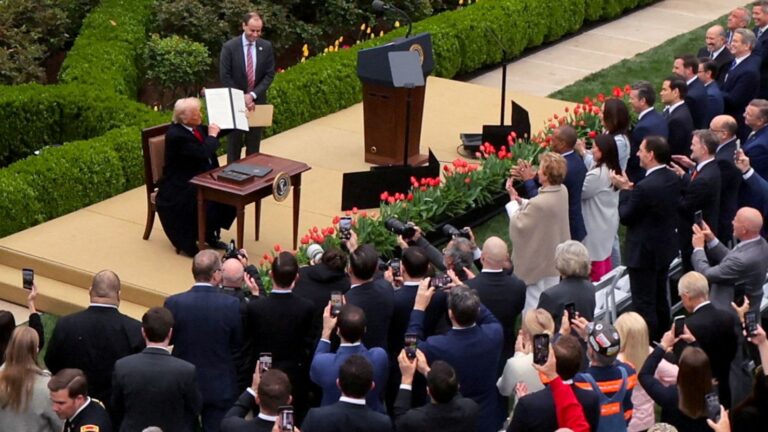🎧 Listen to This Article
Trump’s Renewed Economic Nationalism
President Donald Trump’s re-escalation of tariffs — some as high as 145% on Chinese goods, and a baseline 10% tariff on most imports — is not just a reprise of his 2018-2020 trade war strategy. It’s a bold, polarizing reassertion of protectionist economics in a deeply interdependent global market. But this time, the stakes are higher, the global economy more fragile, and America’s geopolitical leverage arguably thinner.
Trump frames these tariffs as tools to “restore fairness,” arguing the U.S. has been “pillaged” by foreign economies. While this rhetoric resonates with segments of the domestic electorate, it belies a deeper and far more complex reality: tariffs are blunt instruments with sharp economic consequences. They rarely protect domestic jobs in the long term — but they almost always raise prices and spark retaliatory policies.
The Global Economic Shockwave: From Jaguar Land Rover to Jiangsu
1. Businesses Brace for Impact
In a hyperconnected global supply chain, tariffs are no longer confined to bilateral effects. Jaguar Land Rover’s pause in US-bound shipments is just one early signal. Every layer of the supply chain — from powdered aluminum in Tennessee to piston assembly in Mexico — is now under cost pressure. For many multinationals, the new tariff regime is essentially a stealth tax on operational efficiency.
2. Retaliation & Fragmentation
China’s 125% retaliatory tariffs, Canada’s 25% hike on US vehicles, and the EU’s threats of mirror penalties are not just symbolic. These are escalatory triggers in a system already fraying. The World Trade Organization’s authority is waning, and plurilateral trade deals (like CPTPP or RCEP) are quietly becoming havens for countries circumventing US-centric trade drama.
3. Inflationary Pressures in an Already Sensitive Climate
The timing couldn’t be worse. The global economy, post-COVID and post-Ukraine war, is navigating persistent inflationary currents. By increasing import costs on everything from electronics to pharmaceuticals, Trump’s tariffs risk further pushing up consumer prices — especially in the US — while also dampening real wage growth.
Strategic Misstep or Masterstroke? Long-Term Implications
A. Supply Chain Realignments
Expect to see an acceleration of nearshoring and friendshoring. Southeast Asia, Mexico, and parts of Eastern Europe will continue to benefit as companies seek to bypass Chinese-origin labeling and reduce tariff exposure.
But beware the illusion of autonomy: many Chinese firms have already “regionalized” production under local brands. Re-shoring may shift geography, but not necessarily geopolitical leverage.
B. The Tax Spillover
Tariffs are revenue-generating measures — effectively a consumption tax on imports. However, they disproportionately hit small and mid-sized enterprises, which lack the hedging and supply chain flexibility of their multinational counterparts. Policymakers must address this imbalance through targeted tax credits or tariff exemptions tied to domestic investment.
C. The UK and EU: Strategic Tightrope Walkers
The UK, already reeling from post-Brexit realignments, faces a diplomatic and economic dilemma. With £58bn in annual exports to the US, pressure mounts on Prime Minister Starmer to negotiate favorable carve-outs — or face retaliatory action. Meanwhile, the EU’s 90-day pause is an opportunity, not a reprieve. Brussels must pursue a coordinated strategy, balancing assertiveness with pragmatism to avoid fragmentation.
From Firefighting to Future-Proofing
- Establish a Tariff Oversight Commission
A bipartisan, expert-led commission should assess the long-term efficacy and collateral impact of US-imposed tariffs. This data should be made public to demystify the “America First” narrative. - Strengthen Multilateral Dispute Mechanisms
The WTO needs reform, not irrelevance. The G20 should spearhead a parallel dispute resolution system to de-escalate emerging trade wars. - Encourage Regional Trade Pacts with Safeguards
Countries vulnerable to US tariffs — such as the UK, Vietnam, and Canada — should pursue tariff-neutral trade corridors with enforceable arbitration clauses. - Introduce Targeted SME Relief Measures
Governments must offer temporary tax deductions or VAT credits to businesses most exposed to rising input costs from US tariffs.
The Tariff Era’s Real Test
Trump’s tariffs are not just a policy — they’re a litmus test of how modern economies adapt under pressure. In this high-stakes geopolitical theater, trade has become the battlefield, tariffs the blunt weapons. But it’s clarity, collaboration, and policy coherence — not bravado — that will determine which economies emerge stronger.
For further details, clarification, contributions, or any concerns regarding this article, please contact us at editorial@tax.news. We value your feedback and are committed to providing accurate and timely information. Please note that our privacy policy will handle all inquiries



